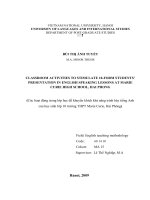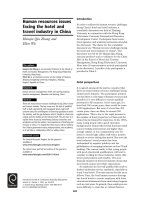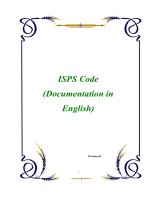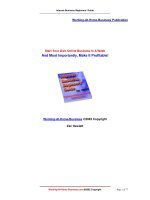Business Communication Reports, Proposal, Presentation in English ppt
Bạn đang xem bản rút gọn của tài liệu. Xem và tải ngay bản đầy đủ của tài liệu tại đây (4.6 MB, 38 trang )
UNIT 4: REPORTS,
PROPOSALS, AND
PRESENTATIONS
LECTURER:
MS DUONG NGOC
PRESENTOR:
GROUP 3
* LY GIA PHAT
* PHAN KIEU DUYEN
* NGUYEN DAO NHU THUY
Unit 4: Reports, proposals, and presentations
C 11
C 12
• Reports and Research Basics
• Informal Business Reports
• Proposals, Business Plans, and Formal
Business Reports
C 13
C 14
• Business Presentations
Chapter 13: Proposals, Business Plans, and Formal
Business Reports
Learning
Objective 1
Preparing Informal Proposals
Learning
Objective 2
Preparing Formal Proposals
Learning
Objective 3
Creating Effective Business Plans
Learning
Objective 4
Writing Formal Business Reports
Learning
Objective 5
Final Writing Tips
C13: Proposals, Business Plans, and Formal Business Reports
Preparing Informal Proposals
• What are Proposals?
Proposals are written offers to solve problems, provide services, or sell
equipment.
• Components of Informal Proposals:
(Figure 13.1):
- introduction
- background
- proposal
- staffing
- budget
- authorization request
C13: Proposals, Business Plans, and Formal Business Reports
Preparing Informal Proposals
C13: Proposals, Business Plans, and Formal Business Reports
Preparing Informal Proposals
Figure 13.2, an informal letter proposal to a Boston dentist to improve patient
satisfaction, illustrates the six parts of letter proposals D:\KD\CN27\HK5\2.Giao
tiep Kinh doanh\PRESENTATION\Figure 13.2.docx
C13: Proposals, Business Plans, and Formal Business Reports
Preparing Informal Proposals
What are six main components of informal proposal?
1. Introduction
Indicate the purpose. Specify why you are making the proposal and
highlighting the writer’s qualifications.
2. Background,
Problem, and
Purpose
Provide necessary background. Discuss the significance of the
proposal and the goals or purposes that matter to the client.
Introduce the problem. Your goal is to convince the reader that a
problem exists or to persuade the reader that you understand the
problem completely.,
3. Proposal, Plan,
and Schedule
Explain the proposal. Present your plan for solving the problem or
meeting the need.
Discuss plan management and evaluation. If appropriate, tell how the
plan will be implemented and evaluated
Outline a timetable. Furnish a schedule showing what will be done and
when.
C13: Proposals, Business Plans, and Formal Business Reports
Preparing Informal Proposals
What are six main components of informal proposal?
4. Staffing
Promote the qualifications of your staff. Explain the specific
credentials and expertise of the key personnel for the project.
Mention special resources and equipment. Show how your support
staff and resources are superior to those of the competition.
5. Budget
Show project costs. For most projects itemize costs. Remember,
however, that proposals are contracts.
Include a deadline. Here or in the conclusion, present a date beyond
which the bid figures are no longer valid.
6. Authorization
Request
Ask for approval. Make it easy for the reader to authorize the
project (for example, Sign and return the duplicate copy).
Chapter 13: Proposals, Business Plans, and Formal
Business Reports
Learning
Objective 1
Preparing Informal Proposals
Learning
Objective 2
Preparing Formal Proposals
Learning
Objective 3
Creating Effective Business Plans
Learning
Objective 4
Writing Formal Business Reports
Learning
Objective 5
Final Writing Tips
C13: Proposals, Business Plans, and Formal Business Reports
Preparing Formal Proposals
C13: Proposals, Business Plans, and Formal Business Reports
Preparing Formal Proposals
Special components of Formal Proposal
1. Copy of the
RFP
A copy of the request for proposal may be included in the front
matter of a formal proposal.
2. Letter of
Transmittal
A letter of transmittal addresses the person who is designated to
receive the proposal or who will make the final decision. This
persuasive letter briefly presents the major features and benefits of
your proposal.
3. Abstract or
Executive
Summary
An abstract is a brief summary (typically one page) of a proposal’s
highlights intended for specialists or technical readers. An
executive summary also reviews the proposal’s highlights, but it is
written for managers and should be less technically oriented
C13: Proposals, Business Plans, and Formal Business Reports
Preparing Formal Proposals
Special components of Formal Proposal
4. Title Page
The title page includes the following items: title of proposal, name
of client organization, RFP number or other announcement, date
of submission, authors’ names, and/or the name of their
organization.
5. Table of
Contents
A table of contents should include all headings and their beginning
page numbers, any appendixes should be listed.
6. List of
Illustrations
An abstract is a brief summary (typically one page) of a proposal’s
highlights intended for specialists or technical readers. An
executive summary also reviews the proposal’s highlights, but it is
written for managers and should be less technically oriented.
7. Appendix
Appendix A might include résumés of the principal investigators or
testimonial letters. Appendix B might include examples or a listing of
previous projects.
Chapter 13: Proposals, Business Plans, and Formal
Business Reports
Learning
Objective 1
Preparing Informal Proposals
Learning
Objective 2
Preparing Formal Proposals
Learning
Objective 3
Creating Effective Business Plans
Learning
Objective 4
Writing Formal Business Reports
Learning
Objective 5
Final Writing Tips
C13: Proposals, Business Plans, and Formal Business Reports
Creating Effective Business Plans
Components of Typical Business Plans
1. Letter of Transmittal
and/or Executive Summary
With Mission
Statement
2. Table of Contents
3. Company Description
4. Product or Service
Description
Explain your reason for writing. Provide your name, address, and
telephone number, along with contact information for all
principals. Include a concise mission statement for your business.
Describe your business explaining the reasons it will succeed.
List the page numbers and topics included in your plan.
Identify the form of your business (proprietorship, partnership, or
corporation) and its type (merchandising, manufacturing, or
service). For existing companies, describe the company’s founding,
growth, sales, and profit.
Explain what you are providing, how it will benefit customers, and
why it is better than existing products or services.
C13: Proposals, Business Plans, and Formal Business Reports
Creating Effective Business Plans
Components of Typical Business Plans
Bplans.co
m
5. Market Analysis
Discuss market characteristics, trends, projected growth, customer
behavior, complementary products and services, and barriers to entry.
Discuss the strengths and weaknesses of your direct and indirect
competitors.
6. Operations and
Management
Explain specifically how you will run your business,
including location, equipment, personnel, and management.
Explain how much money you have, how much you will need to start
7. Financial Analysis up, and how much you will need to stay in business. Including all cost
and fee you need to pay (permits, equipment, insurance, supplies,
advertising and promotions, salaries, tax, and so on).
8. Appendixes
Provide necessary extras such as managers’ résumés, promotional
materials, and product photos, sales forecast, a personnel plan,
anticipated cash flow, profit and loss, and a balance sheet
Chapter 13: Proposals, Business Plans, and Formal
Business Reports
Learning
Objective 1
Preparing Informal Proposals
Learning
Objective 2
Preparing Formal Proposals
Learning
Objective 3
Creating Effective Business Plans
Learning
Objective 4
Writing Formal Business Reports
Learning
Objective 5
Final Writing Tips
Writing
Writing Formal
Formal Business
Business Reports
Reports
C13: Proposals, Business Plans, and Formal Business Reports
Writing
Writing Formal
Formal Business
Business Reports
Reports
Front Matter Components of Typical Business Plans
1. Cover
Formal reports are usually enclosed in vinyl or heavy paper binders
to protect the pages and to give a professional, finished appearance
2. Title Page
Including: (a) name of the report (in all caps); (b) name, title, and
organization of the individual receiving the report; (c) author’s name,
title, and organization; and (d) date submitted
3. Letter of
transmittal
Announce the report topic and explain who authorized it. Briefly
describe the project and preview the conclusions, if the reader is
supportive.
C13: Proposals, Business Plans, and Formal Business Reports
Writing
Writing Formal
Formal Business
Business Reports
Reports
Front Matter Components of Typical Business Plans
4. Table of
contents
Show the beginning page number where each report heading appears
in the report
5. List of
illustrations
Include a list of tables, illustrations, or figures showing the title of the
item and its page number
6. Executive
summary
Summarize the report purpose, findings, conclusions, and
recommendations.
7. Introduction
Explain the problem motivating the report; describe its background
and significance. Clarify the scope and limitations of the report.
C13: Proposals, Business Plans, and Formal Business Reports
Writing
Writing Formal
Formal Business
Business Reports
Reports
Body and Back Matter Components of Typical Business Plans
8. Body
9. Conclusions
10.
Recommendations
11. Appendix
12. Works cited or
references
Discuss, analyze, and interpret the research findings or the
proposed solution to the problem.
Explain what the findings mean in relation to the original problem
Make enumerated recommendations that suggest actions for
solving the problem.
Include items of interest to some, but not all, readers, such as
questionnaires, transcripts of interviews, data sheets, and other
information .
List all sources of information used in your report.
Chapter 13: Proposals, Business Plans, and Formal
Business Reports
Learning
Objective 1
Preparing Informal Proposals
Learning
Objective 2
Preparing Formal Proposals
Learning
Objective 3
Creating Effective Business Plans
Learning
Objective 4
Writing Formal Business Reports
Learning
Objective 5
Final Writing Tips
C13: Proposals, Business Plans, and Formal Business Reports
Final
Final Writing
Writing Tips
Tips
● Allow sufficient time. Develop a realistic timetable and stick to it.
● Finish data collection. Do not begin writing until you have collected all the data and
drawn the primary conclusions. For reports based on survey data, complete the tables
and figures first.
● Work from a good outline. A big project such as a formal report needs the order and
direction provided by a clear outline.
● Provide a proper writing environment. You will need a quiet spot where you can
spread out your materials and work without interruption.
● Use the features of your computer wisely. Use check spelling, check grammar tool.
Save your document often and keep backup copies on disks or memory sticks. Print out
important materials so that you have a hard copy.
C13: Proposals, Business Plans, and Formal Business Reports
Final
Final Writing
Writing Tips
Tips
● Write rapidly; revise later. Record their ideas quickly and save revision until
after the first draft is completed. Rapid writing encourages fluency and creativity.
● Save difficult sections. If some sections are harder to write than others, save
them until you have developed confidence and a rhythm working on easier topics.
● Be consistent in verb tense. Use past-tense verbs to describe completed actions
(for example, the respondents said or the survey showed).
Use present-tense verbs, however, to explain current actions (the purpose of the
report is, this report examines, the table shows).
When citing references, use past-tense verbs (Jones reported that).
C13: Proposals, Business Plans, and Formal Business Reports
Final
Final Writing
Writing Tips
Tips
● Generally avoid I and we. This formal style sometimes results in the overuse of passivevoice verbs (for example, periodicals were consulted and the study was
conducted).
● Let the first draft sit. After completing the first version, put it aside for a day or two. Return
to it with the expectation of revising and improving it. Do not be afraid to make major changes.
● Revise for clarity, coherence, and conciseness. Read a printed copy out loud. Make sure that
your writing is so clear that a busy manager does not have to reread any part.
● Proofread the final copy three times. First, read a printed copy slowly for word meanings
and content.
Then read the copy again for spelling, punctuation, grammar, and other mechanical errors.
Finally, scan the entire report to check its formatting and consistency
(page numbering, indenting, spacing, headings, and so forth).
Unit 4: reports, proposals, and presentations
C 11
C 12
• Reports and Research Basics
• Informal Business Reports
• Proposals, Business Plans, and Formal
Business Reports
C 13
C 14
• Business Presentations









